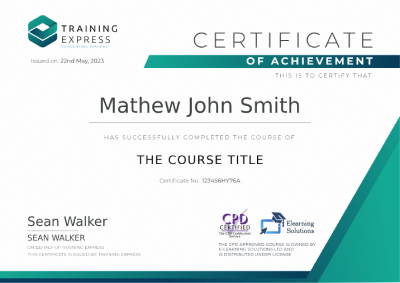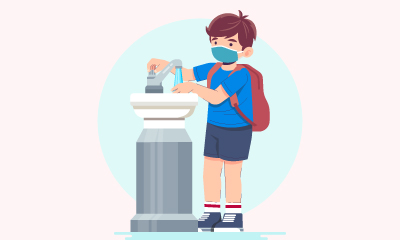GET THIS COURSE AND 1500+ OTHERS FOR ONLY £49 PER YEAR. FIND OUT MORE
16 others bought this course in the last 24 hours!
The Child Health & Safety course is a comprehensive training course for healthcare and social care workers. It provides up-to-date knowledge and skills for those just starting out in their career, or professionals who are looking to develop competency in their field by learning some key best practices.
This course covers practical and theoretical knowledge on topics such as child protection, nutrition and healthy eating, legal responsibilities, learning development and communication. It provides practical training and guidance on how to recognise signs of illness in children, assess if a child is at risk of harm, identify learning needs, and other responsibilities. You will also deepen your understanding of the health, social and educational services available to children, exploring the role of a caregiver and healthcare professional in detail.
We’ve taken this comprehensive professional diploma in child health & safety and broken it down into several manageable modules which we believe will assist you to easily grasp each concept – from the fundamentals to the most advanced aspects of the course. Learn from the experts and get certified with the most in-demand skills to fast track your career.
- Accredited by CPD
- Instant e-certificate and hard copy dispatch by next working day
- Fully online, interactive course with audio voiceover
- Developed by qualified professionals
- Self-paced learning and laptop, tablet, smartphone-friendly
- 24/7 Learning Assistance
- Discounts on bulk purchases
Sneak Peek
Who should take the course
This child health & safety training programmer is suitable for anyone who works with or cares for children, including the following:
- Healthcare professionals
- Teachers
- Childminders
- Child Social Workers
Certification
Once you’ve successfully completed your Child Health & Safety course, you will immediately be sent a digital certificate. Also, you can have your printed certificate delivered by post (shipping cost £3.99). Our certifications have no expiry dates, although we do recommend that you renew them every 12 months.

Learning Outcomes
By the end of the course, learners will be able to:
- Understand your role as a caregiver and healthcare professional
- Keep children healthy and safe while under their care and supervision
- Communicate with children effectively through verbal and nonverbal language
- Teach children the importance of maintaining personal hygiene
- Recognise signs of illness in children and respond to ill health
- Identify accidents and hazards in the classroom, home and workplace
- Understand child safeguarding regulations and legislation in the UK and recognise when a child is at risk of harm
- Support the learning and development of children with special needs
- Discuss the health, social and educational services available to children
- Provide healthy, balanced meals and teach children the importance of nutrition
- Promote self-reliance through setting a routine and schedule
Assessment
At the end of the Child Health & Safety course, there will be an online assessment, which you will need to pass to complete the course. Answers are marked instantly and automatically, allowing you to know straight away whether you have passed. If you haven’t, there’s no limit on the number of times you can take the final exam. All this is included in the one-time fee you paid for the course itself.
Accreditation
All of our courses are fully accredited. The content of the Risk and Compliance Manager course is certified by the CPD Certification Service as conforming to the continuous professional development principles. This course provides you with up-to-date skills and knowledge and helps you to become more competent and effective in your chosen field.
Course Curriculum
- Daily Personal Hygiene
- The High Five of Personal Hygiene
- The Importance of Personal Hygiene
- Ill Health in Children
- Signs to Look For
- Responding to Ill Health (Spots, High Temperature, Sneezing and Coughing, Being Sick, Not Eating Food)
- When to Call an Ambulance
- Accident and Hazards
- Hazards in the Home (Bathroom/Toilet, Kitchen, Bedrooms, Stairs, Living Area)
- Preventing Accidents
- Guidance for Health and Safety
- Toy Safety
- Cleaning Materials
- Taking Children Out
- Keeping Children Safe in the Street
- Safety Equipment and Features
- Safety Features (Window Locks, Cupboard Locks, Safety Gates, Fire Guards, Corner Guards, Plug Covers, Harnesses, Car Child Lock, Car Seat, Gates)
- Fire Safety (Smoke Detectors, Fire Blankets, Fire Extinguishers, Matches and Lighters, Electrical Faults, Chip Pans and Deep Fat Fryers, Candles, Fairy Lights)
- What to Do in a Fire?
- Summary
- Assessment
- Statutory Services
- Health Services for Children
- Social Services for Children
- Education Services for Children
- Leisure Activity and Recreation Services
- Voluntary Services and Self-help Agencies
- Summary/Keynotes of the Module
- Assessment
- What are Special Needs?
- What is Disability?
- Avoiding Stereotypes
- Use of Appropriate and Sensitive Terminology
- Special Education Needs
- Early Support Programme
- Caring for Children with Feeding and Communication Differences
- Caring for Children with Mobility Differences
- Caring for Children with Special Social and Emotional Needs
- Caring for Children with Complex Needs
- Summary/Keynotes of the Module
- Assessment
- Definitions
- Recognition
- Signs of Neglect
- Helping Children to Protect Themselves
- Summary/Keynotes of the Module
- Assessment
- Why Care Matters so Much
- Children Need Touch
- Sources of Concerns about Physical Contact
- Learning about Appropriate Touch
- Routines for Young Children
- Morning, Mid Morning, Lunchtime, Afternoon, Teatime, Bedtime
- Value of Care Routines
- Promoting Self-Reliance through Routines
- Clothing
- Hot Sunny Day
- Rainy Day
- Bitterly Cold Day
- Windy Day
- Bedtime
- Safe
- Clean and Tidy (Right Temperature, A cot or Bed)
- Getting Children Ready for Bed
- Sharing the Care with Children
- Supporting and Encouraging Children
- Children as Partners in Helping Out
- Summary
- Assessment
- Main Food Groups
- Why Food from Each Group is Important
- Making Up a Balanced Diet
- Why a Balanced Diet is Important
- Healthy Meals for Children
- Encouraging Children to Eat Healthy
- Food Allergies to Look For
- Summary/Keynotes of the Module
- Assessment
- Suicide
- History of Suicide
- National Prevention Programmes
- Substance Abuse in Mental Health
- Common Signs of Substance Abuse
- Examples of Substance Abuse
- Depression
- Treatment for Depression
- Risk Factors
- Reducing Access
- Summary
- Assessment
- Conduct/Behaviour Disorders
- Social Information-Processing Theory
- Family-Based Communication and Problem-Solving Training
- Home-School Liaison Meetings and Remedial Tuition
- Development of Fears and Anxieties Causes of Childhood Anxiety
- Cognitive and Behavioural Treatment
- Development of the Concept of Pain
- Family-Based Treatment Approach
- Summary
- Necessity of Communication in Health and Social Care
- Communication in the context of Caregiving
- One-to-one communication
- Group Communication
- Informal Communication
- Formal Communication
- Communication between colleagues
- Communication between professional people and people using services
- Communication with professionals
- Multi-agency working
- Multi-professional working
- Degrees of formality in different contexts
- Forms of Communication
- Types of interpersonal interaction
- Speech/Verbal Communication
- Non-verbal communication
- Communication and language needs and preferences
- British Sign Language
- Makaton
- Braille
- Use of signs and symbols
- Written communication
- Pictures and objects of reference
- Fingerspelling
- Communication passports
- Technological aids to communication
- Human aids to communication
- Variation between cultures
- Building Rapport
- Environmental factors that influence communication
- Barriers to communication
- Barriers associated with personality, self-esteem, anxiety and depression
- Barriers associated with aggression and submissiveness
- Barriers associated with assumptions
- Barriers associated with values and belief systems
- Barriers associated with cultural variation
- Use and abuse of power
- Barriers associated with the effects of alcohol/drugs
- Strategies for overcoming communication barrier
- Summary
- Values promoted by Health and Social care worker
- Freedom of choice
- Rights of service users
- Independence
- Security
- Dignity
- Privacy
- Respect
- What to expect and where to draw the line
- Codes of Conduct
- Accountability
- Promoting and upholding rights of service users
- Collaborating with colleagues
- Open and effective communication
- Respect right of individual of confidentiality
- Continuous professional development
- Boundaries
- Health Care Professionals
- Types of Health Care Professionals
- Voluntary Health Care
- Statutory Health Care
- Primary Health Care
- Secondary Health Care
- Informal Health Care
- Private Health Care
- Examples of other professionals
- District Nurses
- Social Workers
- Care Managers
- Social Services
- Partnerships in Health Care Profession
- Advantages of Working Partnerships
- Summary
- Factors that may increase the risk
- Where risks come from?
- Single Assessment Process
- How to assess if the child is at risk of harm or not?
- How to recognise a risky situation?
- Parental Risk factors
- Parental Mental Health
- Parental Substance Misuse
- Summary
- Assessment
Course Curriculum
 TAKE THIS COURSE
TAKE THIS COURSE
£125.00£20.00 ex VAT- 1 year
- Level 3
- Course Certificate
- 4 hours, 40 minutes Gift this course
Subscribe to this course and 2,000+ top‑rated Training Express courses for your organization.
Try Training Express Business- For teams of 5 or more users
- 2,000+ fresh & in-demand courses
- Learning Engagement tools
- SSO and LMS Integrations
 Food Hygiene
Food Hygiene Health & Safety
Health & Safety Safeguarding
Safeguarding First Aid
First Aid Business Skills
Business Skills Personal Development
Personal Development









